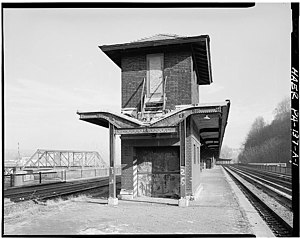Easton station (Pennsylvania)
|
Easton
|
||||||||||||||||
|---|---|---|---|---|---|---|---|---|---|---|---|---|---|---|---|---|
| Former Lehigh Valley Railroad station | ||||||||||||||||

The former station photographed in 1979, prior to its demolition
|
||||||||||||||||
| Location | Third and Canal Street Easton, Pennsylvania |
|||||||||||||||
| Coordinates | 40°41′10″N 75°12′30″W / 40.6861°N 75.2084°WCoordinates: 40°41′10″N 75°12′30″W / 40.6861°N 75.2084°W | |||||||||||||||
| Tracks | 2 | |||||||||||||||
| Construction | ||||||||||||||||
| Disabled access | No | |||||||||||||||
| Electrified | No | |||||||||||||||
| Services | ||||||||||||||||
|
||||||||||||||||
Easton is a defunct train station in Easton, Pennsylvania. It was originally built by the Lehigh Valley Railroad. As of 2017, the structure still exists and was blighted for at least 20 years, since its closing in the 1970s. The city of Easton got permission from Norfolk Southern to clean up the property. The location only recently became a focal point for the city with the opening of Interstate 78 in the 1990s.
The Central Railroad of New Jersey (CNJ) had a station of its own on the other side of the Lehigh River.
The Lehigh Valley Railroad opened its original line between Allentown and Easton, Pennsylvania in 1855; the first passenger train ran between the two cities on June 11. The Lehigh Valley's line ran across the Lehigh River from downtown Easton. For the first year the Lehigh Valley used what chief engineer Robert H. Sayre described as a "temporary passenger depot." A permanent station, built by the CNJ on Lehigh Valley land, opened toward the end of 1856. This new station had two levels: the upper level was used by the CNJ and Lehigh Valley, while the lower level was used by the Belvidere Delaware Railroad. Sayre characterized this station as "combustible" and proposed replacing it with one made of stone.
The Lehigh Valley's second permanent station opened on the same site on September 14, 1868. The Easton Express considered the new structure "handsome." The new building was made of brick and stood two stories high. The lower level contained a baggage room, waiting rooms, a ticket office, and a dining room with attached kitchen. The upper level contained railroad offices.
...
Wikipedia
